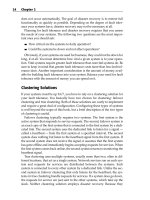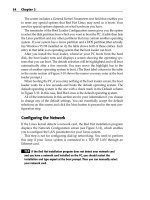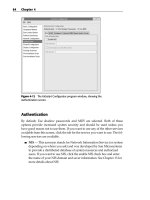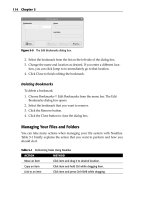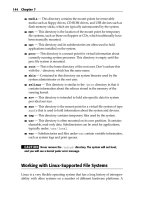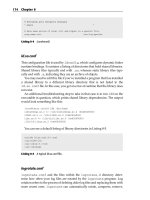Red Hat Linux Networking , System Administration (P1) ppt
Bạn đang xem bản rút gọn của tài liệu. Xem và tải ngay bản đầy đủ của tài liệu tại đây (483.3 KB, 30 trang )
Terry Collings and Kurt Wall
Red Hat
®
Linux
®
Networking and System
Administration
Third Edition
01_599496 ffirs.qxd 8/30/05 6:38 PM Page iii
01_599496 ffirs.qxd 8/30/05 6:38 PM Page ii
Red Hat
®
Linux
®
Networking
and System Administration
Third Edition
01_599496 ffirs.qxd 8/30/05 6:38 PM Page i
01_599496 ffirs.qxd 8/30/05 6:38 PM Page ii
Terry Collings and Kurt Wall
Red Hat
®
Linux
®
Networking and System
Administration
Third Edition
01_599496 ffirs.qxd 8/30/05 6:38 PM Page iii
Red Hat
®
Linux
®
Networking and System Administration, Third Edition
Published by
Wiley Publishing, Inc.
10475 Crosspoint Boulevard
Indianapolis, IN 46256
www.wiley.com
Copyright © 2005 by Wiley Publishing, Inc., Indianapolis, Indiana
Published simultaneously in Canada
ISBN-13: 978-0-7645-9949-1
ISBN-10: 0-7645-9949-6
Manufactured in the United States of America
10 9 8 7 6 5 4 3 2 1
No part of this publication may be reproduced, stored in a retrieval system or transmitted
in any form or by any means, electronic, mechanical, photocopying, recording, scanning
or otherwise, except as permitted under Sections 107 or 108 of the 1976 United States
Copyright Act, without either the prior written permission of the Publisher, or authoriza-
tion through payment of the appropriate per-copy fee to the Copyright Clearance Center,
222 Rosewood Drive, Danvers, MA 01923, (978) 750-8400, fax (978) 646-8600. Requests to
the Publisher for permission should be addressed to the Legal Department, Wiley Publish-
ing, Inc., 10475 Crosspoint Blvd., Indianapolis, IN 46256, (317) 572-3447, fax (317)
572-4355, or online at
/>Limit of Liability/Disclaimer of Warranty: The publisher and the author make no repre-
sentations or warranties with respect to the accuracy or completeness of the contents of
this work and specifically disclaim all warranties, including without limitation warranties
of fitness for a particular purpose. No warranty may be created or extended by sales or
promotional materials. The advice and strategies contained herein may not be suitable for
every situation. This work is sold with the understanding that the publisher is not
engaged in rendering legal, accounting, or other professional services. If professional
assistance is required, the services of a competent professional person should be sought.
Neither the publisher nor the author shall be liable for damages arising herefrom. The fact
that an organization or Website is referred to in this work as a citation and/or a potential
source of further information does not mean that the author or the publisher endorses the
information the organization or Website may provide or recommendations it may make.
Further, readers should be aware that Internet Websites listed in this work may have
changed or disappeared between when this work was written and when it is read.
For general information on our other products and services or to obtain technical support,
please contact our Customer Care Department within the U.S. at (800) 762-2974, outside
the U.S. at (317) 572-3993 or fax (317) 572-4002.
Wiley also publishes its books in a variety of electronic formats. Some content that appears
in print may not be available in electronic books.
Trademarks: Wiley, the Wiley Publishing logo and related trade dress are trademarks or
registered trademarks of John Wiley & Sons, Inc. and/or its affiliates in the United States
and other countries, and may not be used without written permission. Red Hat is a regis-
tered trademark of Red Hat, Inc. Linux is a registered trademark of Linus Torvalds. All
other trademarks are the property of their respective owners. Wiley Publishing, Inc., is not
associated with any product or vendor mentioned in this book.
01_599496 ffirs.qxd 8/30/05 6:38 PM Page iv
Terry Collings is the owner of TAC Technology, located in eastern Pennsylva-
nia. He provides Linux consulting and training services to a variety of clients.
Terry has been an adjunct faculty member at several colleges in his area
where he has taught A+ and Network + certification courses. He also has taught
courses on Unix, Linux, TCP/IP, and Novell Netware.
Terry is the author of Red Hat Enterprise Linux 4 For Dummies and has
co-authored and contributed to several other Linux books. He has been a tech-
nical editor for the following books: KDE Bible, The Samba Book, Unix Weekend
Crash Course, Red Hat Linux 9 For Dummies, Solaris 9 For Dummies, Fedora Linux
2 For Dummies, and Linux Timesaving Techniques For Dummies.
Kurt Wall first touched a computer in 1980 when he learned FORTRAN on an
IBM mainframe of forgotten vintage; things have improved since then. A pro-
fessional technical writer by trade, a historian by training, and an all-around
Linux guy by avocation, Kurt’s work history is diverse. These days, Kurt works
in the Customer Engineering group at TimeSys Corporation in Pittsburgh,
Pennsylvania. His primary responsibilities include building and maintain-
ing TimeSys’s Developer Exchange and working with portal customers and
users. He also fixes broken servers, writes documentation, and builds TimeSys
software.
Kurt, who dislikes writing about himself in the third person, receives entirely
too much e-mail at
About the Authors
v
01_599496 ffirs.qxd 8/30/05 6:38 PM Page v
Credits
Acquisitions Editor
Debra Williams Cauley
Development Editor
Sydney Jones
Technical Editor
William von Hagen
Production Editor
Angela Smith
Copy Editor
Foxxe Editorial Services
Editorial Manager
Mary Beth Wakefield
Production Manager
Tim Tate
Vice President & Executive Group
Publisher
Richard Swadley
Vice President and Publisher
Joseph B. Wikert
Graphics and Production Specialists
Carrie Foster
Denny Hager
Jennifer Heleine
Stephanie D. Jumper
Ron Terry
Quality Control Technicians
Amanda Briggs
John Greenough
Susan Moritz
Joe Niesen
Proofreading and Indexing
TECHBOOKS Production Services
01_599496 ffirs.qxd 8/30/05 6:38 PM Page vi
This book is dedicated to my wife, Nancy, and daughter, Sabrina,
who bring joy and wonder every day.
—Terry Collings
To my new wife, Kelly, who is indeed flesh
of my flesh and bone of my bone.
—Kurt Wall
01_599496 ffirs.qxd 8/30/05 6:38 PM Page vii
01_599496 ffirs.qxd 8/30/05 6:38 PM Page viii
Red Hat produces the most popular distribution of Linux currently in use. It is
a robust, reliable operating system that can run on a variety of hardware, from
personal computers to large mainframes. Linux in general, Fedora Core 4 and
Red Hat Enterprise Linux in particular, are very powerful operating systems
that can be used at the enterprise level as a full-fledged server. Linux functions
equally well at the enterprise-workstation level for typical user applications,
as well as on home PCs. For those of us dissatisfied with the reliability and
security of other commercially available operating systems, Fedora Core 4 and
Red Hat Enterprise Linux are a pleasant alternative.
How This Book Is Organized
This book is divided into five parts and one appendix, each covering a specific
area of functionality in a typical Fedora Core 4 and Red Hat Enterprise Linux
system. In this book, the third edition, we have added more chapters that
cover areas we discussed in the first and second editions in more detail or that
explore material not covered in the first or second editions. With this edition,
the book now contains 35 chapters and a rather large appendix, a considerable
increase in content since the first edition was released three years ago. We
want to emphasize that this book is useful for users of Fedora Core, the open
source community–based Linux project supported by Red Hat, as well as users
of Red Hat Enterprise Linux.
Preface
ix
02_599496 fpref.qxd 8/30/05 6:17 PM Page ix
Part I: System and Network Administration Defined
This part sets the stage and defines the role of a system administrator, begin-
ning with an explanation of the duties of a system administrator and continu-
ing through installing your system and finishing with descriptions of the file
system and system configuration files. Chapter 1 explains some of the com-
mon tasks an administrator may perform, such as installing servers and appli-
cation software, managing user accounts, and backing up and restoring files.
Chapter 2 details the steps involved in planning and implementing a network,
including security and disaster-recovery considerations. Chapter 3 covers all
the steps required to install Fedora Core or Red Hat Enterprise Linux on a local
system using the most typical installation method. Chapter 4 gives you
instructions on using Kickstart to perform system installations on remote sys-
tems. Chapter 5 gives you an introduction to the GNOME and KDE graphical
user environments and helps you find your way around the desktop. Chap-
ter 6 teaches you about the startup and shutdown process of your system,
including the GRUB boot loader and the init process. In Chapter 7, you explore
the details of the file system hierarchy and learn about other supported file
systems. Part I ends with Chapter 8, which lists the system and network con-
figuration files and explains the purpose of each file.
Part II: Network Services
This part of the book is where you learn about the networking services avail-
able in Fedora Core and Red Hat Enterprise Linux. Beginning with Chapter 9,
you learn about the X Window system used to provide a graphical working
environment as well as font management. Chapter 10 tells you how to config-
ure your printers to use the Common Unix Printing System (CUPS), the
default printing system used by Fedora Core and Red Hat Enterprise Linux. In
Chapter 11, you learn about the TCP/IP protocol suite and how to configure it
on your system. Chapter 12 explains the configuration of the Network File
System (NFS) used to share files with other Linux or UNIX computers on your
network. Chapter 13 gives you the details about the Network Information Sys-
tem (NIS) and configuration instructions. If you have computers running
Microsoft Windows NT, 2000, or XP, you will want to read Chapter 14 to learn
how to share files with them using Samba. Chapter 14 also provides instruc-
tions on connecting a client to Novell networks so you can share files with
these systems as well. Chapter 15 gives you the details of installing and con-
figuring an Oracle database on your server. In Chapter 16 you learn about set-
ting up a VNC server to provide remote access with a graphical interface.
Chapter 17 is all about convenience and some of the convenience services you
x Preface
02_599496 fpref.qxd 8/30/05 6:17 PM Page x
can provide with your system. The last chapter in this part, Chapter 18, gives
you some helpful tips for optimizing the services discussed in Part II.
Part III: Internet Services
Internet services are somewhat different from network services on an internal
network, and Chapter 19 begins this part by explaining what we mean by
Internet services. Included in this chapter is an explanation of the Xinetd and
TCP wrappers configuration files. The ability to convert domain names to IP
addresses is a fundamental part of providing Internet services. Chapter 20
explains how to configure BIND on your system to provide this service. The
next three chapters provide installation and configuration instructions for
three commonly used Internet services. Chapter 21 describes the process of
sending e-mail and how to configure Sendmail, the most commonly used mail
transfer agent, as well as Postfix, which is quickly gaining popularity. Chapter
22 explains setting up an FTP server on your system. Chapter 23 covers the
most widely used Web server, Apache, and explains the configuration process.
In Chapter 24 you learn about other common Web services that you can pro-
vide. The last chapter in Part III, Chapter 25, provides some optimization
information for the services covered in this part of the book.
Part IV: System Administration
The goal of this part of the book is to provide enough information so you have
a fundamental understanding of the tasks required to maintain your system
and ensure that it runs well. Chapter 26 explains the up2date program that is
included with Fedora Core and Enterprise Linux that you can use to keep your
system updated. Also covered is the Red Hat Network, a subscription service
available with Red Hat Enterprise Linux that you can use to keep your system
current. You can register your systems with Red Hat and then receive auto-
matic notifications of updated or new software that can be installed. Some-
times it is advantageous to upgrade or recompile your kernel for your specific
needs. Chapter 27 discusses the pros and cons of making changes and pro-
vides instructions to recompile your kernel. If you would rather do your sys-
tem configuration from a command prompt instead of using many of the
available GUI tools, Chapter 28 is for you. This chapter provides command
prompt configuration instructions, as well as instructions to create scripts to
automate many routine administration tasks. Chapter 29 tells you all you need
to know to effectively manage the users and groups on your system. In Chap-
ter 30, you learn how to install and upgrade software packages on your sys-
tem. And in the last chapter in this part, Chapter 31, you explore the process of
backing up the files on your system and how to restore them.
Preface xi
02_599496 fpref.qxd 8/30/05 6:17 PM Page xi
Part V: System Security and Problem Solving
Most of the last part of the book deals with performance monitoring and tun-
ing, and securing your system, with a final chapter on general system trou-
bleshooting. Maintaining a secure system is a critical area of concern for
system administrators. Chapter 32 explains the basic steps involved in moni-
toring your system’s performance to keep it running as quickly as it should.
Chapter 33 addresses a new topic in this edition, SELinux, the access-based
security system developed by the National Security Agency. Continuing the
discussion of security, Chapter 34 gives you an explanation of firewalls and
Internet security and the risks involved with connections from outside your
network. You also learn about LDAP and Kerberos and their role in network
security. The last chapter in this part, Chapter 35, provides some general trou-
bleshooting tips and techniques and lists some problems you may encounter
during normal operation of your system and the steps to take to solve the
problems discussed.
Appendix A
This appendix is new to this edition. We had a lot of information about shell
scripting and couldn’t find a good place for it in the parts, so we put it here. If
you want to become a shell-scripting pro, read this section.
How to Use This Book
Our intention in this book is to cover the Fedora Core and Red Hat Enterprise
Linux operating system in enough detail to provide the answers you need. The
book is divided into the parts previously discussed to make it easy for you to
go to the specific part for the topic you need to learn about. You can use the
book as a reference for whatever you need to know about a particular topic.
Using This Book’s Icons
Look for the following margin icons to help you get the most out of this book:
TIP Tips provide special information or advice.
CAUTION Caution icons warn you of a potential problem or error.
xii Preface
02_599496 fpref.qxd 8/30/05 6:17 PM Page xii
CROSS-REFERENCE Cross-references direct you to related information in
another section or chapter.
NOTE Notes highlight areas of interest or special concern related to a topic.
Conventions
This book uses the following conventions for explanations of how to do things
on your computer:
■■
Italic type introduces new technical terms. It also indicates replaceable
arguments that you should substitute with actual values — the con-
text makes clear the distinction between new terms and replaceable
arguments.
■■
Bold shows a command you type.
■■
Monospaced text distinguishes commands, options, and arguments
from surrounding explanatory content.
■■
Keys to press in combination are shown as in this example:
Ctrl+Alt+Delete means to press all three keys at the same time.
■■
The term click means to press the left mouse button once. Double-click
means to press the left button twice in quick succession. Right-click
means to press the right mouse button once. Drag means to hold down
the left mouse button and move the mouse while holding down the
button.
Preface xiii
02_599496 fpref.qxd 8/30/05 6:17 PM Page xiii
02_599496 fpref.qxd 8/30/05 6:17 PM Page xiv
Terry Collings: My first thought when I was asked to write the third edition of
this book was Wow! Now we are doing a third edition, so what can I say now?
It appears that we did a good-enough job on the first and second editions that
many people bought the book and found it useful. So to everyone who bought
the first and second editions of the book and made it possible for us to do yet
another edition, here’s a big thank you!
Thanks to Kurt Wall, my co-author, for again doing a great job in our collab-
oration on this new edition. Kurt is very easy to work with, and I hope I’ll have
a chance to work with him again. Thanks, Kurt, and I wish you all the best in
your recent marriage!
This book would not have been possible without the hard work of everyone
at John Wiley & Sons, especially our acquisitions editor, Debra Williams Cauley,
and our development editor, Sydney Jones. Debra and Sydney are both con-
summate professionals who were always there to answer our questions or con-
cerns and make sure we kept on track. Thanks go to our copy editor, technical
editor, and production staff at Wiley for ensuring that our book is technically
accurate and grammatically correct.
Finally, I would like to thank my wife, Nancy, for all the hours she spent
keeping our daughter Sabrina entertained so I could work undisturbed com-
pleting this new edition.
Kurt Wall: I agree with Terry: thanks to everyone who bought the previous
editions of this book, which made it possible for us to write this one. Unlike
Terry, though, I knew what I’d say because many of you contacted me to let me
know what we’d missed. Thank you. It is a privilege and an honor to write for
you; I hope this book is worthy of that trust.
Acknowledgments
xv
03_599496 fbetw.qxd 8/30/05 6:37 PM Page xv
I’m grateful to Terry for again allowing me to work on this book with him.
Let’s do this again, eh? As usual, the staff at Wiley has been terrific, despite the
fact that they drove us to meet an insane deadline. Debra Williams Cauley, our
Acquisitions Editor and Voice of Deadlines Missed, is just a doll; Sydney Jones
worked hard to mash the text into something presentable. Thank you Debra
and Sydney. Kudos to the unsung, unnamed others who converted the manu-
script into printable copy and who never get enough credit.
Our technical editor and my friend and colleague from TimeSys, Bill von
Hagen, helped us write a tighter, more relevant book. Bill also gets an award
for keeping me sane during YAB (Yet Another Book) and for keeping me enter-
tained during YADATO (Yet Another Day At The Office). Thanks, Bill! Thanks
also to Christopher Faylor, another TimeSys colleague, for reviewing the chap-
ter on RPM and to Tim Wunder, who suggested improvements in the Web ser-
vices chapter. Any remaining mistakes are either figments of your imagination
or my responsibility.
Tim Wunder and the other residents of the Linux Step-by-Step mailing list
( />users) were quite forthcoming with ideas and input when I asked for it.
They’ve been a great group of people with whom to converse these last 12
years and are a big part of the reason I keep getting to write books about Linux.
Thanks guys. Hats off to Red Hat Software and the Fedora Core Project earn
mention here for providing our subject matter.
My agent, Marta Justak, is happy to see me finally nail a deadline but wants
to know what Debra does that she couldn’t. Beats me! Thanks to Kevin Bartlett
for miscellaneous corrections and to Krischan Jodies for his excellent ipcalc
tool. Above all, if I have any talent as a writer, credit goes to God who gave me
the talent, provided me the opportunities to develop and use it, and kept me
sober long enough to do so. Thanks and Amen.
xvi Acknowledgments
03_599496 fbetw.qxd 8/30/05 6:37 PM Page xvi
Preface ix
Acknowledgments xv
Part One System and Network Administration Defined 1
Chapter 1 Duties of the System Administrator 3
The Linux System Administrator 3
Installing and Configuring Servers 5
Installing and Configuring Application Software 6
Creating and Maintaining User Accounts 7
Backing Up and Restoring Files 7
Monitoring and Tuning Performance 9
Configuring a Secure System 10
Using Tools to Monitor Security 12
Summary 12
Chapter 2 Planning the Network 13
Deciding How Your Network Will Be Used 13
Understanding Topologies 15
Star Topology 15
Bus Topology 16
Ring Topology 16
Tree Topology 17
Client-Server or Peer-to-Peer? 18
What’s in the Mix? 19
Determining System Requirements 20
Planning and Implementing Security 21
Addressing External and Internal Threats 21
Formulating a Security Policy 22
Contents
xvii
04_599496 ftoc.qxd 8/30/05 7:08 PM Page xvii
An Effective Password Policy 22
General Security Rules 22
Security Updates 23
An Appropriate Firewall System 23
Planning for Recovery from Disasters 23
Clustering Solutions 24
Disaster Recovery 25
Writing It Down: Good Records Can Save Your Job 26
Summary 28
Chapter 3 Standard Installation 29
Exploring Your PC’s Components 30
Processor 30
Bus 30
Memory 31
Video Card and Monitor 31
Hard Drive 32
Floppy Disk Drive 32
Keyboard and Mouse 33
SCSI Controller 33
CD/DVD-R/RW Drive 33
Sound Card 33
Network Card 34
Checking for Supported Hardware 34
Creating the Red Hat Boot Disk 35
Starting the Installation 36
Partitioning the Hard Disk 42
Using Disk Druid to Partition Your Disks 45
Naming Disks and Devices 45
Mounting a File System 46
Understanding the Swap Partition 47
Preparing Disk Partitions 47
Setting Up the Partitions 49
Configuring the Installation 51
Installing the Boot Loader 51
Configuring the Network 54
Configuring the Firewall 56
Choosing Additional Languages 58
Setting the Time Zone 59
Setting the Root Password 61
Selecting the Package Groups to Install 62
Running Firstboot 65
Summary 70
Chapter 4 Kickstart Installation 71
Using the Kickstart Configurator 71
Installing the Kickstart Configurator 72
xviii Contents
04_599496 ftoc.qxd 8/30/05 7:08 PM Page xviii
Boot Loader Options Screen 77
Partition Information Screen 78
Network Configuration 83
Authentication 84
Firewall Configuration 86
Display Configuration 87
Package Selection 90
Pre-Installation Script 91
Post-Installation Script 92
Starting the Kickstart Installation 93
Creating a Bootable Floppy 93
Creating a Bootable CD-ROM 94
Starting a Kickstart Installation 95
Summary 96
Chapter 5 Exploring the Desktops 97
Examining the Graphical Login Screen 97
Logging In and Using the GNOME Desktop 99
Playing with the Panel 101
Managing Applets on the Panel 102
Choosing Items from the Applications Menu in Fedora Core 103
Choosing Items from the Places Menu in Fedora Core 105
Choosing Items from the Desktop Menu in Fedora Core 106
Choosing Items from the Applications Menu
on Enterprise Linux 107
Choosing Actions from the Actions Menu in Enterprise Linux 109
Using the Nautilus File Manager 110
Displaying Your Home Folder 112
Displaying the Contents of a Folder 112
Opening Files 112
Accessing FTP Sites 113
Using Bookmarks 113
Adding a Bookmark 113
Editing Bookmarks 113
Deleting Bookmarks 114
Managing Your Files and Folders 114
Customizing the Nautilus File Manager 115
Editing File Manager Preferences 115
Changing the File Manager Background and Icon Emblems 117
Showing and Hiding Views 118
Configuring GNOME 118
Logging Out 119
Taking a Look at KDE 119
Managing Applets 121
Choosing Applications from the Applications Menu 122
Using the Konqueror File Manager 124
Logging Out of KDE 126
Summary 126
Contents xix
04_599496 ftoc.qxd 8/30/05 7:08 PM Page xix
Chapter 6 System Startup and Shutdown 127
Examining the Boot Process 128
The Boot Loader 128
Using GRUB during Boot 130
The Kernel 132
The /sbin/init Program 133
Exploring Runlevels 136
Changing the System Runlevel 136
Starting Programs at System Boot 137
Shutting Down the System 138
GRUB Configuration File 139
Summary 140
Chapter 7 The File System Explained 141
Understanding the File System Structure 141
The / Directory 143
Working with Linux-Supported File Systems 144
ext3 145
ext2 146
reiserfs 146
SystemV 147
ufs 147
FAT 147
NTFS 147
IBM JFS 147
SGI XFS 148
Nonstandard Linux File Systems 148
FREEVxFS 148
GFS 148
Memory and Virtual File Systems 149
cramfs 149
tmpfs 149
ramfs 150
romfs 150
proc 150
Proc Software Information 150
Proc Hardware Information 152
/dev/pts 154
devfs 154
sysfs 155
Linux Disk Management 155
Disk Partitioning on an x86 Machine 155
Mounting Other OS Partitions/Slices 155
Metadevices 156
Logical Volumes 156
RAID 160
Summary 161
xx Contents
04_599496 ftoc.qxd 8/30/05 7:08 PM Page xx
Chapter 8 Examining the System Configuration Files 163
Examining the System Configuration Files 164
Systemwide Shell Configuration Scripts 164
Shell Config Scripts: bashrc, csh.cshrc, zshrc 165
bash, tcsh, zsh, and Their Config File Read Orders 167
System Environmental Settings 168
/etc/motd 168
issue 168
issue.net 168
aliases 169
fstab 169
grub.conf 170
cron files 171
syslog.conf 172
ld.so.conf 174
logrotate.conf 174
Examining the /etc/sysconfig/ Directory 175
/etc/sysconfig/apmd 176
/etc/sysconfig/authconfig 177
/etc/sysconfig/clock 177
/etc/sysconfig/crond 178
/etc/sysconfig/desktop 178
/etc/sysconfig/firstboot 178
/etc/sysconfig/grub 178
/etc/sysconfig/harddisks 178
/etc/sysconfig/hwconf 179
/etc/sysconfig/i18n 179
/etc/sysconfig/init 179
/etc/sysconfig/iptables 180
/etc/sysconfig/irda 181
/etc/sysconfig/kernel 181
/etc/sysconfig/keyboard 181
/etc/sysconfig/kudzu 182
/etc/sysconfig/mouse 182
/etc/sysconfig/named 183
/etc/sysconfig/netdump 183
/etc/sysconfig/network 184
/etc/sysconfig/ntpd 184
/etc/sysconfig/pcmcia 184
/etc/sysconfig/selinux 185
/etc/sysconfig/system-config-users 185
/etc/sysconfig/system-logviewer 185
/etc/sysconfig/samba 186
/etc/sysconfig/sendmail 186
/etc/sysconfig/vncservers 186
/etc/sysconfig/xinetd 187
Contents xxi
04_599496 ftoc.qxd 8/30/05 7:08 PM Page xxi
Directories in the /etc/sysconfig/ Directory 187
apm-scripts 187
daemons 187
networking 187
network-scripts 188
rhn 188
Examining the Network Configuration Files 188
Files to Change When Setting Up a System
or Moving the System 188
Setting Up the IP Address 189
Setting Up the Hostname 190
Setting Up the DNS Name Resolution 190
Making a Local File of Hostname to IP Address Mappings 191
Setting Up Name Service Resolution Order 192
Starting Up Network Services from xinetd 193
Starting Up Network Services from the rc Scripts 194
Other Important Network Configuration Files
in the /etc/sysconfig Directory 195
static-routes 195
Iptables 195
Network Configuration Files in
/etc/sysconfig/network-scripts 196
ifcfg-networkinterfacename 196
ifup and ifdown 196
Managing the init Scripts 196
Managing rc Scripts by Hand 198
Managing rc Scripts Using chkconfig 200
Summary 202
Part Two Network Services 203
Chapter 9 Managing the X Window System 205
Configuring the X Server with the X Configuration Tool 205
Changing the Display Resolution 206
Changing the Display Color Depth 207
Changing Monitor Type Settings 207
Changing Your Video Card Type 208
Configuring Dual Monitors 209
Manually Configuring Your X Server 210
The X Server Configuration File 210
Summary 215
Chapter 10 Configuring Printers 217
Configuring Printers with the Printer Configuration Tool 217
Configuring the Print Queue 219
Selecting the Print Driver 224
xxii Contents
04_599496 ftoc.qxd 8/30/05 7:08 PM Page xxii




